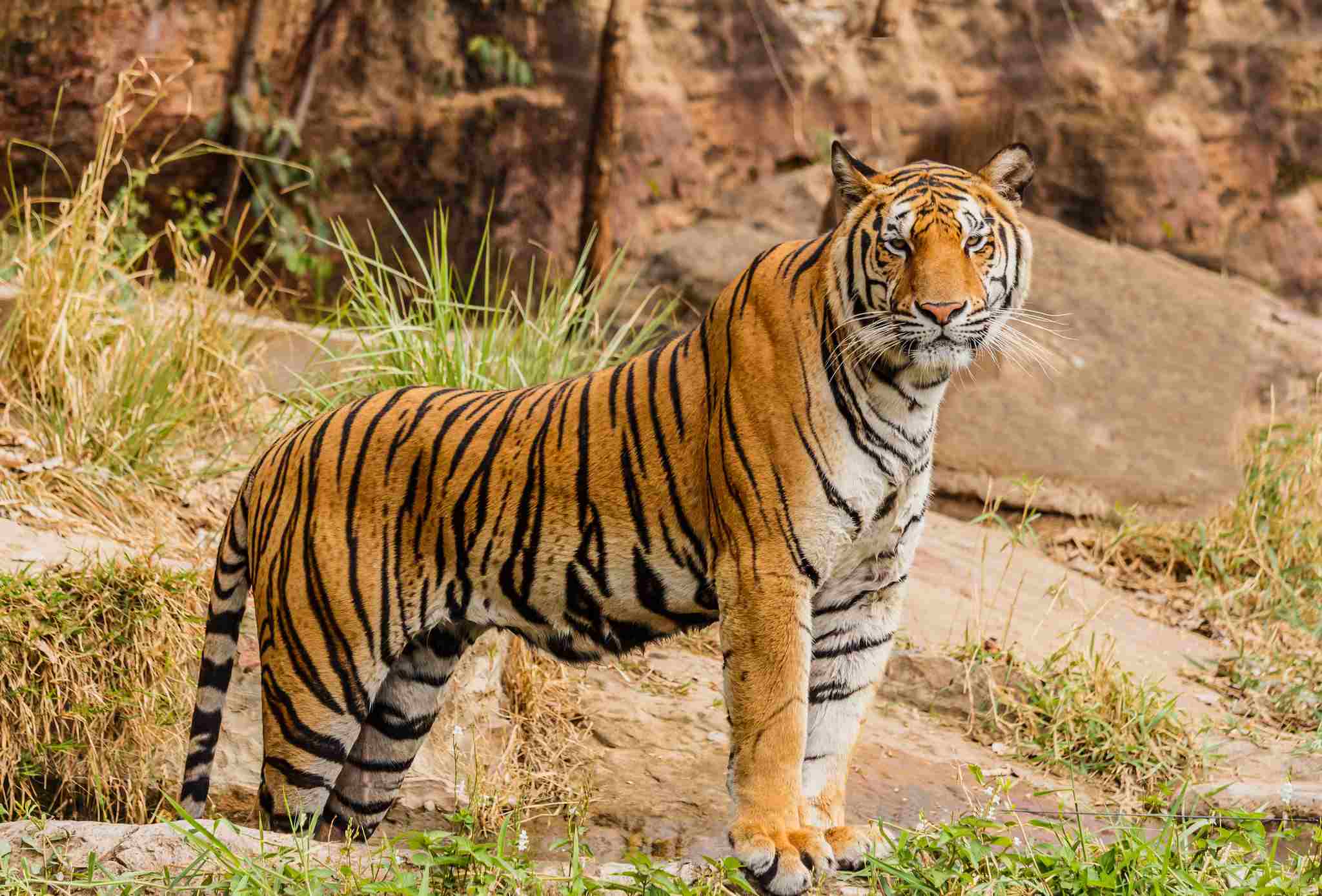Do Tigers Eat Monkeys? 17+ Prey Animals for Tigers Discussed
Yes, tigers are known to eat monkeys, although they may not be their primary prey. Tigers may capture monkeys when the opportunity arises, but they mostly prey on other animals.
In addition to monkeys, tigers are known to eat fish, snakes, leopards, bears, wolves, crocodiles, rabbits, geckos, orangutans, alligators, turtles, elephants, deer, foxes, antelopes, buffaloes, and even insects like termites. The most common prey for tigers are large ungulates like deer and buffaloes. However, tigers are opportunistic predators and will eat other animals, including fellow predators and felines, when they are available.
This article provides a comprehensive list and discussion of various animals that tigers may prey upon, in no particular order.
What Tigers Eat: An Overview
Tigers eat other animals like fish, snakes, leopards, bears, wolves, crocodiles, rabbits, geckos, orangutans, alligators, turtles, elephants, deer, foxes, antelopes, buffaloes, and even insects like termites
The most common prey for tigers are large ungulates like deer and buffaloes, but they also opportunistically eat other animal including fellow predators and felines, when these are available.
1). Fish (Do Tigers Eat Fish?)
Tigers are known to eat fish, especially those that inhabit wetlands and are close to aquatic ecosystems. They have been observed consuming various types of fish, including those found in rivers, lakes, and ponds. Fish can be an important part of a tiger’s diet, providing them with a source of protein and nutrients.
Tigers are skilled hunters and are able to catch fish using their sharp claws and powerful jaws. They may also eat other aquatic creatures such as turtles and amphibians that live in the same habitat. However, it’s important to note that fish are not the primary prey for tigers, and they are more commonly known to hunt and consume larger ungulates like deer and buffaloes. Nevertheless, when fish are available, tigers will opportunistically include them in their diet.
2). Snakes (Do Tigers Eat Snakes?)
Tigers are known to have a diverse diet, and snakes are one of the prey animals they occasionally consume. While tigers primarily hunt and feed on larger ungulates like deer and buffaloes, they have been observed eating snakes as well. Tigers have the ability to hunt and consume both smaller species of snakes and larger pythons.
Snakes that are venomous or non-venomous can be on the menu for tigers. Tigers are skilled hunters and have the agility and strength to catch and overpower snakes. They use their sharp claws and powerful jaws to capture and kill their prey. Tigers may also eat other reptiles like lizards and turtles if they are available in their habitat.
However, it’s important to note that snakes are not the preferred prey for tigers. They are more commonly known to target larger mammals for their sustenance. Snakes are considered a potential prey for tigers, but they are not a significant part of their diet. Tigers opportunistically include snakes in their diet when they come across them during their hunting expeditions.
3). Leopards (Do Tigers Eat Leopards?)
Tigers are known to occasionally eat leopards and other smaller felines, although such instances are rare. There have been documented cases of tigers hunting and consuming leopards, such as the incident that occurred in Rajasthan’s Ranthambore National Park in early 2023. Tigers have the ability to target and prey on leopards if the opportunity arises.
Leopards can be considered a potential prey for tigers, although they are not a significant part of their diet. Tigers primarily focus on larger ungulates like deer and buffaloes for their sustenance. However, when circumstances allow, tigers will not hesitate to hunt and eat leopards.
Tigers possess the necessary hunting skills, agility, and strength to overpower and consume leopards. They utilize their sharp claws and powerful jaws to capture and kill their prey. While leopards are not the preferred prey for tigers, they are included in their diet opportunistically when encountered during hunting expeditions.
4). Bears (Do Tigers Eat Bears?)
Tigers are known to prey on bears like grizzly bears and black bears. While it is not a common occurrence, tigers will target bears if the opportunity presents itself. Bears can be considered a potential prey for tigers, although they are not a significant part of their diet.
Tigers primarily focus on larger ungulates like deer and buffaloes for their sustenance. However, when circumstances allow, tigers will not hesitate to hunt and eat bears. Tigers possess the necessary hunting skills, agility, and strength to overpower and consume bears. They utilize their sharp claws and powerful jaws to capture and kill their prey.
In regions where tigers and bears share habitats, such as parts of Russia and China, there have been occasional reports of tigers preying on bears. These interactions are usually driven by competition for resources or territorial disputes. Tigers are apex predators and will take advantage of any available food source, including bears.
It is important to note that tigers are opportunistic hunters and will target a variety of prey depending on availability. While bears are not the preferred prey for tigers, they are included in their diet when encountered during hunting expeditions.

5). Wolves (Do Tigers Eat Wolves?)
Asian wolf species like the Indian wolf and the Tibetan wolf are potential prey for tigers. Tigers will feed on wolves mostly when their preferred prey, such as deer or buffaloes, are scarce or unavailable. Wolves are not a primary food source for tigers, but they can be targeted if the opportunity arises.
Tigers possess the necessary hunting skills and strength to overpower and consume wolves. They are known for their agility and use their sharp claws and powerful jaws to capture and kill their prey. In regions where tigers and wolves share habitats, there have been occasional reports of tigers preying on wolves.
However, it is important to note that wolves are highly social and often live in packs, which can make them formidable opponents. Wolves have a strong sense of teamwork and can defend themselves against predators, including tigers. Tigers may think twice before targeting a pack of wolves due to the potential risk involved.
6). Crocodiles (Do Tigers Eat Crocodiles?)
Crocodiles are formidable predators, known for their size and strength. While crocodiles are generally larger than tigers, tigers have the advantage of agility and speed. Tigers can use their stealth and camouflage to ambush crocodiles, especially when they are near the water’s edge.
Although tigers are not known to actively seek out crocodiles as prey, there have been rare instances where tigers have been observed hunting and consuming crocodiles. In some cases, tigers may target smaller or injured crocodiles that are more vulnerable. However, it is important to note that these instances are not common and crocodiles are not a primary food source for tigers.
On the other hand, it is worth mentioning that crocodiles are opportunistic predators and have been known to prey on various animals, including tigers. While it is rare for a crocodile to successfully hunt and consume a tiger, it is not entirely impossible. In certain situations, such as when a tiger is weakened or injured, a crocodile may take advantage of the opportunity and attempt to prey on the tiger.
7). Rabbits (Do Tigers Eat Rabbits?)
Rabbits are not a primary food source for tigers, but they can be considered as potential prey. Tigers are carnivores and primarily hunt larger animals such as deer and boars. However, in certain circumstances, tigers may resort to smaller mammals like rabbits if they are the only ones available.
In their natural habitat, tigers do not commonly come across rabbits. Tigers are typically found in dense forests and grasslands, while rabbits are more commonly found in open fields and meadows. The habitats of tigers and rabbits do not often overlap, which reduces the chances of tigers encountering rabbits as prey.
That being said, tigers are opportunistic hunters and will eat whatever is available to them. If a tiger comes across a rabbit and is in need of food, it may choose to hunt and consume it. Tigers have powerful jaws and sharp teeth that are capable of capturing and killing smaller prey like rabbits.
In addition to rabbits, tigers may also eat other rodents such as rats and mice. These small mammals can provide a source of food for tigers when larger prey is scarce. Tigers have the ability to adapt their hunting strategies based on the availability of prey in their environment.
It is important to note that while tigers may eat rabbits if necessary, it is not a common occurrence. Tigers primarily rely on larger herbivores for their sustenance. The size and energy requirements of tigers make it more efficient for them to hunt and consume larger prey.
8). Birds (Do Tigers Eat Birds?)
Tigers are known to prey on birds, although it is not very common compared to their hunting of larger animals. While tigers primarily target larger herbivores like deer and boars, they are opportunistic hunters and will take advantage of any available food source. Birds can be a potential prey for tigers, especially if they are in need of food and come across a suitable opportunity.
Tigers have the agility and speed to capture birds in flight. They can use their powerful jaws and sharp teeth to catch and kill them. However, hunting birds requires a different set of skills compared to hunting larger mammals. Tigers may need to adapt their hunting strategies to successfully capture birds, as they are smaller and more agile than their usual prey.
In their natural habitat, tigers may encounter various species of birds, including waterfowl, game birds, and smaller songbirds. The specific types of birds that tigers prey on can vary depending on the region and the availability of different bird species. Tigers are known to inhabit diverse habitats, ranging from dense forests to grasslands, which provide opportunities for encounters with different bird species.
It is important to note that while tigers may prey on birds, it is not a common occurrence compared to their hunting of larger animals. Tigers have specific dietary requirements and rely on larger herbivores for their sustenance. The energy and effort required to hunt and consume birds may not be as efficient for tigers compared to hunting larger prey.
9). Geckos (Do Tigers Eat Geckos?)
Geckos are a potential prey for tigers, although they are not a common food source for these large predators. Tigers primarily target larger herbivores like deer and boars, but they are opportunistic hunters and will take advantage of any available food source. While geckos may not be a significant part of a tiger’s diet, they can still be hunted if the opportunity arises.
Tigers possess incredible agility and speed, which allows them to capture geckos with relative ease. Geckos are small and agile reptiles, making them a challenging target for tigers compared to their usual prey. Tigers may need to adapt their hunting strategies to successfully capture geckos, utilizing their powerful jaws and sharp teeth to catch and kill them.
In the natural habitats where tigers reside, geckos can be found in various regions. These reptiles are known for their ability to climb walls and ceilings, making them accessible to tigers in certain environments. Tigers that inhabit areas with dense forests or rocky terrain may encounter geckos more frequently than those in other habitats.
It is important to note that geckos are not a primary food source for tigers. Tigers have specific dietary requirements and rely on larger herbivores for their sustenance. While geckos may be hunted if the opportunity presents itself, the energy and effort required to capture and consume them may not be as efficient for tigers compared to hunting larger prey.
10). Orangutans (Do Tigers Eat Orangutans?)
Orangutans are not a common prey for tigers, but they can be considered a potential food source for these large predators. Tigers primarily target larger herbivores like deer and boars, but they are opportunistic hunters and will take advantage of any available prey. While orangutans may not be a significant part of a tiger’s diet, they can still be hunted if the opportunity arises.
Tigers possess incredible strength and agility, which allows them to overpower orangutans when they are on the ground. Orangutans are arboreal primates, spending most of their time in trees, which makes them less accessible to tigers compared to their usual prey. However, if an orangutan descends to the ground, it becomes vulnerable to a tiger’s ambush.
In the natural habitats where tigers and orangutans coexist, such as the rainforests of Sumatra and Borneo, encounters between the two species are rare. Tigers primarily rely on larger herbivores for their sustenance, and orangutans are not a preferred food source. Tigers are more likely to target animals that are easier to catch and provide a higher caloric intake.
It is important to note that tigers and orangutans have overlapping habitats but different ecological niches. Tigers are apex predators, while orangutans are arboreal herbivores. Their dietary preferences and behaviors are distinct, reducing the likelihood of direct interactions between the two species.
Conservation efforts are crucial to protect both tigers and orangutans, as their populations are threatened by habitat loss and poaching. By preserving their natural habitats and implementing measures to prevent human-wildlife conflicts, we can ensure the survival of these magnificent creatures.
11). Alligators (Do Tigers Eat Alligators?)
While alligators are not a common prey for tigers, there have been instances where tigers have been known to eat Chinese alligators. The South China tiger, specifically, has been observed preying on Chinese alligators in their natural habitat. However, it is important to note that this is not a regular occurrence and tigers primarily target larger herbivores for their sustenance.
Tigers possess incredible strength and agility, which allows them to overpower alligators if the opportunity arises. However, due to the differences in habitat and behavior, encounters between tigers and alligators are rare. Alligators are primarily found in freshwater habitats, while tigers inhabit a variety of ecosystems including forests and grasslands.
In the wild, tigers are more likely to target animals that are easier to catch and provide a higher caloric intake. This typically includes larger herbivores such as deer and boars. Alligators, with their powerful jaws and aquatic lifestyle, are not a preferred food source for tigers.
Conservation efforts are crucial to protect both tigers and alligators, as their populations are threatened by habitat loss and human activities. By preserving their natural habitats and implementing measures to prevent human-wildlife conflicts, we can ensure the survival of these magnificent creatures.
12). Turtles (Do Tigers Eat Turtles?)
Turtles are another potential prey for tigers, especially in aquatic areas. Tigers, with their powerful jaws and hunting skills, can target turtles as a food source. However, it is important to note that turtles are not a primary food choice for tigers. Tigers are more likely to focus on larger herbivores that provide a higher caloric intake.
In their natural habitat, tigers may come across turtles in bodies of water such as rivers, lakes, or ponds. Turtles, with their protective shells, can be challenging for tigers to prey upon. Tigers may need to use their strength and agility to flip the turtle over and expose its vulnerable underside.
While turtles may be a potential food source for tigers, it is not a common occurrence. Tigers are more likely to target animals that are easier to catch and provide a greater amount of meat. This typically includes larger herbivores like deer and boars.
Additionally, conservation efforts are crucial to protect both tigers and turtles. Tigers are endangered species, and turtles also face threats such as habitat loss and illegal trade.
13). Elephants (Do Tigers Eat Elephants?)
Tigers are known for their strength and hunting skills, but do they eat elephants? While tigers are capable of taking down large prey, they rarely attack healthy adult elephants due to their size and power. Elephants are formidable creatures that can defend themselves against predators, making them a challenging target for tigers.
However, tigers may prey on unprotected elephant calves or sick and injured adult elephants. These vulnerable individuals are easier for tigers to overpower and provide a potential food source. In such cases, tigers may take advantage of the elephant’s weakened state to secure a meal.
It is important to note that elephants are not a primary food choice for tigers. Tigers are more likely to focus on animals that are easier to catch and provide a higher caloric intake. This typically includes smaller herbivores like deer and boars.
Conservation efforts are crucial to protect both tigers and elephants. Tigers are endangered species, and elephants also face threats such as poaching and habitat loss. Preserving their habitats and implementing measures to prevent human-wildlife conflict are essential for the survival of these magnificent creatures.
14). Deer (Do Tigers Eat Deer?)
Deer are among the most common prey for tigers in their natural habitat. Tigers are skilled hunters and have adapted their hunting techniques to successfully capture and kill deer. These ungulates, including species like the sambar deer and chital deer, provide a significant food source for tigers.
Tigers are known for their stealth and agility, which allows them to silently approach their prey. They use their powerful muscles and sharp claws to bring down deer with a swift and lethal attack. Tigers often target vulnerable individuals, such as young or injured deer, as they are easier to catch and subdue.
The abundance of deer in certain regions makes them an attractive food choice for tigers. Forested areas with dense vegetation provide the perfect hunting grounds for tigers to stalk and ambush deer. The camouflage provided by their striped fur allows tigers to blend seamlessly into their surroundings, increasing their chances of a successful hunt.
When hunting deer, tigers primarily target the vital organs, such as the neck or throat, to quickly incapacitate their prey. Once the deer is immobilized, the tiger will drag it to a secluded location to consume its meal. Tigers are known to be solitary feeders, and they will often consume a large portion of the deer at once, ensuring they have enough sustenance for several days.
It is important to note that the relationship between tigers and deer is a natural part of the ecosystem. Tigers play a crucial role in regulating deer populations, preventing overgrazing and maintaining a healthy balance in the ecosystem. This predator-prey dynamic is essential for the overall health and biodiversity of the habitat.
Conservation efforts aimed at protecting both tigers and deer are vital. Tigers are an endangered species, and the loss of their natural habitat and prey can have severe consequences for their survival. By preserving the habitats of both tigers and deer and implementing measures to reduce human-wildlife conflict, we can ensure the continued existence of these magnificent creatures.
15). Foxes (Do Tigers Eat Foxes?)
Foxes are a potential prey for tigers in Asia. Tigers, being powerful predators, have been known to hunt and consume foxes as part of their diet. These small carnivores are agile and quick, making them a challenging target for tigers.
In the dense forests and grasslands of Asia, foxes can be found in abundance. Their small size and ability to adapt to various habitats make them an attractive food source for tigers. Tigers rely on their stealth and speed to catch foxes, using their sharp claws and powerful jaws to deliver a swift and lethal attack.
Tigers often target vulnerable foxes, such as young or injured individuals, as they are easier to catch and overpower. Foxes are known for their agility and cunning, but even their evasive maneuvers may not be enough to escape the grasp of a hungry tiger. Tigers have been observed to employ various hunting techniques, including stalking and ambushing, to successfully capture foxes.
Once a tiger has caught a fox, it will typically consume the entire prey at once. Tigers are solitary feeders and will ensure they have enough sustenance for several days. The consumption of foxes provides tigers with essential nutrients and energy to sustain their large bodies and maintain their predatory lifestyle.
The relationship between tigers and foxes is an important part of the ecosystem in Asia. Tigers play a crucial role in controlling the population of foxes, preventing their overabundance and maintaining a balance in the ecosystem. This predator-prey dynamic contributes to the overall health and biodiversity of the region.
16). Antelopes
Antelopes, like gazelles, are a potential prey of tigers. These graceful herbivores are known for their speed and agility, making them a challenging target for tigers. Tigers, being powerful predators, have been observed hunting and consuming antelopes as part of their diet.
In the grasslands and open savannahs where antelopes thrive, tigers utilize their stealth and camouflage to approach their prey undetected. With a combination of strength, speed, and precision, tigers launch a swift and lethal attack on antelopes. Their sharp claws and powerful jaws enable them to overpower these agile herbivores.
Tigers often target vulnerable antelopes, such as the young, sick, or injured individuals, as they are easier to catch and subdue. Antelopes rely on their speed and herd behavior to evade predators, but even their evasive maneuvers may not be enough to escape the relentless pursuit of a hungry tiger. Tigers employ various hunting techniques, including stalking and chasing, to successfully capture antelopes.
Once a tiger has caught an antelope, it will consume the entire prey at once. Tigers are solitary feeders and will ensure they have enough sustenance for several days. The consumption of antelopes provides tigers with the necessary nutrients and energy to support their large bodies and maintain their predatory lifestyle.
17). Buffaloes
Buffaloes, like water buffalo, are a potential prey of tigers. These large herbivores are found in various habitats, including grasslands, swamps, and forests, making them an accessible food source for tigers. Tigers are known to hunt and consume buffaloes as part of their diet, utilizing their strength and stealth to overpower these formidable animals.
When hunting buffaloes, tigers rely on their powerful physique and sharp claws to bring down their prey. Buffaloes are known for their size and strength, often weighing several times more than a tiger. However, tigers are skilled predators and have been observed successfully taking down buffaloes by targeting vulnerable individuals or working together in groups.
Tigers employ different hunting strategies when targeting buffaloes. They may stalk their prey, patiently waiting for the opportune moment to launch a surprise attack. Alternatively, tigers may chase buffaloes over long distances, utilizing their speed and agility to keep up with their prey. Once a tiger catches a buffalo, it will use its powerful jaws to deliver a fatal bite to the neck or throat, ensuring a swift and efficient kill.
After bringing down a buffalo, tigers will consume the entire prey, including the meat, organs, and bones. Tigers are known to be opportunistic feeders and will scavenge on carcasses if necessary. The consumption of buffaloes provides tigers with a substantial amount of protein and energy, allowing them to sustain their large bodies and active lifestyle.
It is important to note that while buffaloes are a potential prey for tigers, they are not the primary source of food. Tigers have a diverse diet and will consume a variety of prey animals depending on their availability and habitat. Buffaloes, however, play a significant role in the diet of tigers in certain regions, especially where they are abundant.
18). Insects
Insects, such as termites and beetles, are a potential prey of tigers. These small creatures may not seem like a substantial meal for a large predator like a tiger, but they play an important role in the tiger’s diet. Tigers are known to consume insects as a source of protein and nutrients, especially when other prey animals are scarce.
Termites, in particular, are a favored food of tigers. These social insects live in large colonies and build intricate mounds. Tigers have been observed using their sharp claws and powerful jaws to tear open termite mounds and extract the insects inside. This behavior is not only a testament to the tiger’s resourcefulness but also highlights their ability to adapt to different food sources.
Beetles are another type of insect that tigers may consume. These small creatures can be found in various habitats, including forests and grasslands, making them accessible to tigers. Tigers may hunt beetles by using their keen sense of hearing and sight to locate them, and then pounce on them with lightning speed.
While insects may not provide a substantial amount of meat, they are an important supplement to the tiger’s diet. Insects are rich in protein and other essential nutrients, which are necessary for the tiger’s growth, reproduction, and overall health. Tigers have evolved to be versatile hunters, capable of adapting to different prey animals depending on their availability.
It is important to note that while insects are a potential prey for tigers, they are not the primary source of food. Tigers primarily rely on larger prey animals, such as deer and wild boar, for their sustenance. However, insects play a role in the tiger’s diet, especially during times of scarcity or when other prey animals are not readily available.
Do Tigers Eat Their Young?
Yes, there have been instances where tigers have been known to eat their own young. However, this behavior is not common and usually occurs under specific circumstances.
One of the main reasons why tigers may resort to eating their young is extreme food scarcity and starvation. In times of limited prey availability, tigers may struggle to find enough food to sustain themselves, let alone their cubs. In such desperate situations, a mother tiger may make the difficult decision to consume her own offspring as a means of survival. This is a heartbreaking but necessary adaptation to ensure her own survival and increase her chances of reproducing again in the future.
Another factor that may lead to a tiger eating its young is when the cubs exhibit anomalous behavior or have physical disabilities. In the wild, tigers rely on their agility, strength, and hunting skills to survive. If a cub is born with a significant physical disability that hinders its ability to keep up with the rest of the litter or poses a threat to the survival of the entire family, the mother tiger may see no other option but to eliminate the weak link. This behavior is a natural instinct to ensure the overall strength and survival of the tiger population.
It is important to note that these instances of tigers eating their young are relatively rare and occur in extreme circumstances. Tigers, like many other animals, have a strong maternal instinct to protect and care for their offspring.
Do Tigers Eat Lions?
No, tigers do not typically eat lions. While both tigers and lions are apex predators and belong to the same family, they inhabit different ecoregion habitats and have distinct hunting behaviors. Tigers are found in Asia, particularly in countries like India, Russia, and Indonesia, while lions are native to Africa, with their largest populations in countries like Tanzania, Kenya, and South Africa. Due to their geographical separation, the chances of tigers and lions encountering each other in the wild are extremely rare.
In some rare cases, when tigers and lions are kept together in captivity, there have been instances of aggression and even fatal attacks between the two species. These incidents are not representative of their natural behavior in the wild, but rather a result of the unnatural conditions and stress of captivity. Tigers and lions are territorial animals, and when confined in close proximity, they may exhibit aggressive behavior towards each other.
It is important to note that tigers and lions have different hunting strategies and prey preferences. Tigers are solitary hunters and rely on stealth and ambush to capture their prey. They primarily target large ungulates such as deer, wild boar, and buffalo. On the other hand, lions are social animals that live in prides and often hunt cooperatively. They tend to target larger herbivores like zebras, wildebeest, and giraffes.
While tigers and lions may have similar physical capabilities as apex predators, their different habitats and hunting behaviors make it unlikely for them to come into direct conflict in the wild. Each species has evolved to thrive in its respective environment and has adapted its hunting techniques accordingly.
How Much Meat Does a Tiger Eat a Day?
A tiger typically consumes an average of 24.8 pounds of meat per day, which is approximately 5.5 percent of its total body weight. Considering that the average body weight of tigers is around 450 pounds for both males and females, this means that tigers consume a significant amount of meat to sustain themselves. However, it’s important to note that tigers do not consume meat on a daily basis, especially in the wild.
In the wild, tigers are opportunistic hunters and their feeding patterns are influenced by various factors such as prey availability and hunting success. They do not have a consistent daily intake of meat but rather consume large quantities of meat at irregular intervals. This is because tigers need to conserve energy and ensure their survival in their natural habitat.
Tigers are known to be powerful predators and their large size requires them to consume substantial amounts of meat to meet their energy requirements. Their diet primarily consists of large ungulates such as deer, wild boar, and buffalo. These prey animals provide the necessary nutrients and energy for tigers to thrive.

Are Tigers Aggressive to Humans?
Tigers are mostly avoidant of humans, rather than aggressive, and do not view them as their preferred prey. However, there are certain circumstances in which tigers may exhibit aggression towards humans. One such circumstance is when a tiger feels threatened or cornered. In these situations, a tiger may display aggressive behavior as a means of self-defense.
Additionally, if a tiger is physically unable to obtain its preferred prey due to impairment, such as broken teeth or old age, it may resort to hunting easier targets, including humans. This is a rare occurrence, but it highlights the importance of maintaining a safe distance from wild tigers.
Furthermore, if the preferred prey of tigers becomes scarce in their natural habitat, they may be more inclined to target humans as an alternative food source. This is why it is crucial to ensure the conservation and protection of tiger habitats, as it helps to sustain their natural prey-predator relationships, while minimiizing conflict with humans
Do Tigers Eat People?
Tigers do not naturally or commonly prey on humans. They do not view humans as their preferred food source. Tigers are apex predators and typically target animals that are smaller in size and easier to catch. However, there are certain circumstances in which tigers may resort to attacking humans.
One such circumstance is when a tiger feels threatened or cornered. Like any wild animal, tigers have a natural instinct to defend themselves when they perceive a threat. In these situations, a tiger may exhibit aggressive behavior towards humans as a means of self-defense. It is important to remember that tigers are powerful and can be dangerous, especially when they feel threatened.
Another reason why tigers may attack humans is if they are physically unable to obtain their preferred prey. For example, if a tiger has broken teeth or is old and unable to hunt effectively, it may target easier prey, including humans. This is a rare occurrence, but it highlights the importance of maintaining a safe distance from wild tigers and respecting their natural habitat.
It is crucial to note that tigers primarily rely on their natural prey for sustenance. They have evolved to hunt and feed on animals such as deer, wild boar, and other ungulates. Tigers are highly adapted to their specific ecological niche, and their diet consists mainly of herbivores. Therefore, as long as their natural prey is available and abundant, tigers are unlikely to target humans.
Conclusion
* In this article, we have explored the various prey animals that tigers consume in their natural habitat.
* From fish and snakes to leopards and bears, tigers have a diverse diet that includes both aquatic and terrestrial creatures.
* We have also discussed the circumstances in which tigers may resort to attacking humans, emphasizing that it is a rare occurrence and usually happens when they feel threatened or unable to obtain their preferred prey.
* It is important to note that tigers primarily rely on their natural prey for sustenance and are unlikely to target humans as long as their preferred food source is available.
* Overall, tigers are apex predators that play a crucial role in maintaining the balance of ecosystems they inhabit.
Additional Questions
1). How Often Do Tigers Eat?
Tigers typically eat once in two to three days on average. The frequency of their meals depends on factors such as the size of their prey and the availability of food in their habitat. Tigers are opportunistic hunters and will consume a large amount of food in one sitting, which can sustain them for several days.
However, if food is scarce, they may need to hunt more frequently to meet their nutritional needs. Additionally, the size of the prey they consume can also affect their feeding frequency. Larger prey animals provide more sustenance, allowing tigers to go longer between meals. Conversely, smaller prey may require tigers to hunt more frequently to satisfy their hunger.
2). What Do Tigers Eat in the Rainforest?
In the rainforest, tigers have a diverse range of prey animals to choose from. They are skilled hunters and adapt their diet to the available food sources in their habitat. Tigers in the rainforest primarily feed on large herbivores such as deer and wild boars. These animals provide the necessary nutrients and energy for the tigers to survive in the dense vegetation of the rainforest.
Additionally, tigers in the rainforest may also prey on smaller animals like monkeys and squirrels.
3). What Do White Tigers Eat?
White tigers have a similar diet to their orange counterparts. They primarily feed on animals like deer and wild boars, which provide them with the necessary nutrients and energy. However, white tigers are also known to eat smaller prey animals such as monkeys and squirrels. These agile and nimble creatures make for a challenging hunt, but white tigers are skilled predators and can adapt to different prey sizes.
Additionally, white tigers may consume smaller mammals like rabbits and birds. Their diet largely depends on the availability of prey in their habitat.
4). Do Tigers Eat Other Tigers?
Tigers do not naturally eat other tigers. They are solitary animals and tend to avoid direct confrontation with each other. However, there have been rare instances where tigers have been known to eat other tigers under certain conditions, such as territorial disputes or scarcity of prey. In these cases, the dominant tiger may kill and consume a weaker or injured tiger.
It is important to note that these instances are extremely rare and not a common behavior among tigers. Tigers primarily prey on a variety of animals such as deer, wild boars, and smaller mammals like rabbits and birds. Their diet is based on the availability of prey in their habitat.
In terms of tiger cubs, there have been reports of adult male tigers killing and eating tiger cubs. This behavior is believed to be a way for the male tiger to assert dominance and eliminate potential competition for resources.
5). Do Tigers Eat Cheetahs?
Tigers and cheetahs do not share the same habitat, which significantly reduces the chances of them encountering each other. Tigers are primarily found in dense forests and grasslands, while cheetahs inhabit open savannahs and grasslands. Due to their distinct habitats, tigers and cheetahs have minimal overlap in their territories, making it unlikely for them to interact or prey upon each other.
Furthermore, tigers are much larger and more powerful than cheetahs, which may deter any potential confrontations. Tigers are known for their strength and ability to take down larger prey, such as deer and wild boars. Cheetahs, on the other hand, rely on their incredible speed to chase down smaller prey like gazelles.
6). Do Tigers Eat Hippos?
Tigers do not eat hippos. This is primarily because tigers and hippos do not inhabit the same ecoregion. Tigers are typically found in dense forests and grasslands, while hippos are native to sub-Saharan Africa, specifically in rivers, lakes, and swamps. The distinct habitats of these two animals greatly reduce the chances of them encountering each other.
Additionally, hippos are large and aggressive animals, known for their territorial behavior and powerful jaws. Tigers, being intelligent predators, are likely to avoid confrontations with such formidable opponents. Tigers typically prey on smaller to medium-sized animals, such as deer and wild boars, which are easier to capture and subdue.
7). Do Tigers Eat Giraffes?
Tigers do not eat giraffes. This is primarily because tigers and giraffes do not inhabit the same region. Tigers are typically found in dense forests and grasslands, while giraffes are native to the savannahs and open woodlands of Africa. The distinct habitats of these two animals greatly reduce the chances of them crossing paths.
Furthermore, giraffes are large and powerful animals, with their long necks and strong kicks as defense mechanisms. Tigers, being intelligent predators, are likely to avoid confrontations with such formidable opponents. Tigers typically prey on animals that are easier to capture and subdue, such as deer and wild boars.
8). Do Tigers Eat Hyenas?
Tigers do not eat hyenas. This is mainly because tigers and hyenas do not inhabit the same ecoregion. Tigers are primarily found in dense forests and grasslands, while hyenas are typically found in savannahs and arid regions. The geographical separation between these two animals greatly reduces the likelihood of them encountering each other.
Additionally, hyenas are known for their strong jaws and powerful bites, which they use to scavenge and consume large carcasses. Tigers, on the other hand, are skilled hunters that prefer to target live prey. The hunting strategies and dietary preferences of these two animals are quite different, further minimizing the chances of them interacting in the wild.
9). Do Tigers Eat Coyotes?
Tigers do not eat coyotes. This is mainly due to the fact that tigers and coyotes inhabit different geographic locations. Tigers are typically found in dense forests and grasslands in Asia, while coyotes are native to North and Central America. The geographical separation between these two animals greatly reduces the chances of them crossing paths in the wild.
Furthermore, tigers are apex predators and prefer to hunt larger prey such as deer, boars, and even smaller ungulates like antelopes. Coyotes, on the other hand, are opportunistic omnivores that primarily feed on small mammals, birds, and carrion. Their dietary preferences and hunting strategies differ significantly, making it unlikely for tigers to consider coyotes as a viable food source.
While there have been instances of tigers and coyotes coexisting in captivity, such as in zoos or wildlife sanctuaries, these interactions are carefully managed and do not reflect the natural behavior of these animals in the wild. In their respective habitats, tigers and coyotes have evolved to occupy different ecological niches, resulting in minimal overlap in their diets and hunting patterns.
10). Do Tigers Eat Eagles?
Tigers can eat eagles, but it is a rare occurrence. Tigers are primarily terrestrial predators, and their diet mainly consists of land-dwelling animals such as deer, boars, and antelopes. Eagles, on the other hand, are aerial predators that primarily feed on smaller birds, fish, and small mammals. The hunting strategies and habitats of tigers and eagles are quite different, which limits their interactions in the wild.
While there have been isolated reports of tigers preying on eagles, these instances are uncommon and usually happen when the opportunity presents itself. Tigers are opportunistic hunters and may take advantage of a vulnerable or injured eagle if the chance arises. However, it is important to note that eagles are not a significant part of a tiger’s diet, and they are not a preferred or regular food source for these big cats.
11). Do Tigers Eat Rhinos?
Tigers do not typically eat rhinos as they are large and powerful animals. However, there have been rare instances where tigers have opportunistically preyed on young, sick, injured, or old rhinos. These situations are not common and do not represent a regular part of a tiger’s diet.
Rhinos are formidable creatures with thick skin and a strong build, making them challenging prey for tigers. Tigers primarily target smaller and more agile animals that are easier to catch and subdue. Rhinos also have a strong defense mechanism with their sharp horns, which can pose a significant threat to tigers.
12). Do Tigers Eat Hawks?
Hawks are not a common prey for tigers, as they are birds and tigers primarily target mammals. Tigers are known to have a diverse diet, but birds like hawks are not a significant part of it. Tigers are more likely to hunt and consume animals such as deer, rabbits, and even smaller primates like monkeys.
Hawks, with their ability to fly and their small size, are not easy targets for tigers. Tigers prefer to focus on animals that are easier to catch and subdue on the ground. While there may be rare instances where a tiger may opportunistically prey on a hawk, it is not a regular occurrence in their diet.
13). Do Tigers Eat Gazelles?
Gazelles are not a common prey for tigers. Tigers primarily target larger mammals such as deer and antelopes. While gazelles are a type of antelope, they are smaller and more agile, making them harder for tigers to catch. Tigers prefer to focus on animals that are easier to subdue and provide a substantial amount of meat.
However, in rare instances where a tiger encounters a vulnerable or injured gazelle, it may opportunistically prey on it. Overall, gazelles are not a significant part of a tiger’s diet, and they are more likely to hunt and consume larger prey animals.

14). What do White Bengal Tigers Eat?
White Bengal tigers have a varied diet, consisting of various animals including deer, antelopes, and wild boars. These majestic creatures are skilled hunters and can take down large prey with their powerful jaws and sharp claws. While their diet primarily consists of herbivorous animals, they are also known to eat smaller mammals like rabbits and rodents.
White Bengal tigers are opportunistic predators and will consume any available food source in their habitat. Their diet may vary depending on the availability of prey and their hunting success.
15). Do Tigers Eat Jaguars?
Tigers and jaguars are two distinct species of big cats that inhabit different regions of the world. Tigers are found in Asia, while jaguars are native to the Americas. Due to their geographical separation, tigers and jaguars do not share the same habitat and therefore do not interact in the wild.
Tigers primarily prey on animals found in their own habitat, such as deer, antelopes, and wild boars. Jaguars, on the other hand, have a diet that includes smaller mammals, fish, and reptiles. While both tigers and jaguars are powerful predators, they have evolved to adapt to their specific environments and prey availability. Therefore, it is unlikely that tigers eat jaguars or vice versa.





